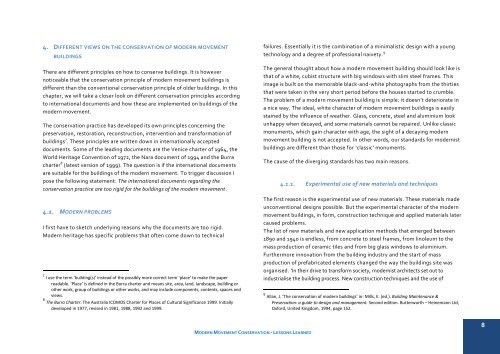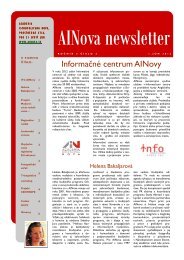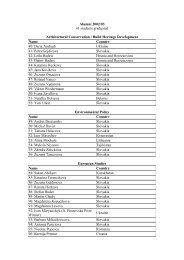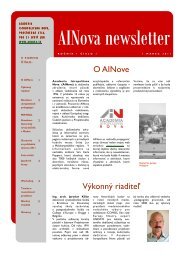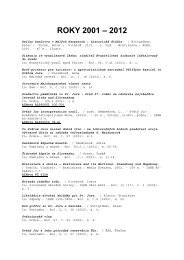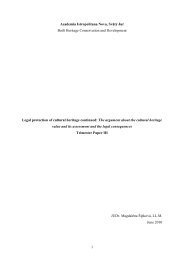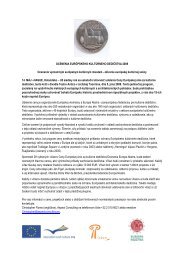modern movement modern movement conservations lessons learned
modern movement modern movement conservations lessons learned
modern movement modern movement conservations lessons learned
Create successful ePaper yourself
Turn your PDF publications into a flip-book with our unique Google optimized e-Paper software.
4. DIFFERENT VIEWS ON THE CONSERVATION OF MODERN MOVEMENTBUILDINGSThere are different principles on how to conserve buildings. It is howevernoticeable that the conservation principle of <strong>modern</strong> <strong>movement</strong> buildings isdifferent than the conventional conservation principle of older buildings. In thischapter, we will take a closer look on different conservation principles accordingto international documents and how these are implemented on buildings of the<strong>modern</strong> <strong>movement</strong>.The conservation practice has developed its own principles concerning thepreservation, restoration, reconstruction, intervention and transformation ofbuildings 7 . These principles are written down in internationally accepteddocuments. Some of the leading documents are the Venice charter of 1964, theWorld Heritage Convention of 1972, the Nara document of 1994 and the Burracharter 8 (latest version of 1999). The question is if the international documentsare suitable for the buildings of the <strong>modern</strong> <strong>movement</strong>. To trigger discussion Ipose the following statement: The international documents regarding theconservation practice are too rigid for the buildings of the <strong>modern</strong> <strong>movement</strong>.4.1. MODERN PROBLEMSI first have to sketch underlying reasons why the documents are too rigid.Modern heritage has specific problems that often come down to technical7 I use the term ‘building(s)’ instead of the possibly more correct term ‘place’ to make the paperreadable. ‘Place’ is defined in the Burra charter and means site, area, land, landscape, building orother work, group of buildings or other works, and may include components, contents, spaces andviews.8 The Burra Charter: The Australia ICOMOS Charter for Places of Cultural Significance 1999. Initiallydeveloped in 1977, revised in 1981, 1988, 1992 and 1999.failures. Essentially it is the combination of a minimalistic design with a youngtechnology and a degree of professional naivety. 9The general thought about how a <strong>modern</strong> <strong>movement</strong> building should look like isthat of a white, cubist structure with big windows with slim steel frames. Thisimage is built on the memorable black-and-white photographs from the thirtiesthat were taken in the very short period before the houses started to crumble.The problem of a <strong>modern</strong> <strong>movement</strong> building is simple: it doesn’t deteriorate ina nice way. The ideal, white character of <strong>modern</strong> <strong>movement</strong> buildings is easilystained by the influence of weather. Glass, concrete, steel and aluminium lookunhappy when decayed, and some materials cannot be repaired. Unlike classicmonuments, which gain character with age, the sight of a decaying <strong>modern</strong><strong>movement</strong> building is not accepted. In other words, our standards for <strong>modern</strong>istbuildings are different than those for ‘classic’ monuments.The cause of the diverging standards has two main reasons.4.1.1. Experimental use of new materials and techniquesThe first reason is the experimental use of new materials. These materials madeunconventional designs possible. But the experimental character of the <strong>modern</strong><strong>movement</strong> buildings, in form, construction technique and applied materials latercaused problems.The list of new materials and new application methods that emerged between1890 and 1940 is endless, from concrete to steel frames, from linoleum to themass production of ceramic tiles and from big glass windows to aluminium.Furthermore innovation from the building industry and the start of massproduction of prefabricated elements changed the way the buildings site wasorganised. ‘In their drive to transform society, <strong>modern</strong>ist architects set out toindustrialise the building process. New construction techniques and the use of9 Allan, J. ‘The conservation of <strong>modern</strong> buildings’ in: Mills, E. (ed.). Building Maintenance &Preservation: a guide to design and management. Second edition. Butterworth – Heinemann Ltd,Oxford, United Kingdom, 1994, page 152.MODERN MOVEMENT CONSERVATION - LESSONS LEARNED8


